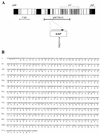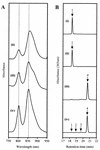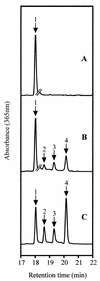Physical mapping and functional assignment of the geranylgeranyl-bacteriochlorophyll reductase gene, bchP, of Rhodobacter sphaeroides
- PMID: 10572128
- PMCID: PMC103687
- DOI: 10.1128/JB.181.23.7248-7255.1999
Physical mapping and functional assignment of the geranylgeranyl-bacteriochlorophyll reductase gene, bchP, of Rhodobacter sphaeroides
Abstract
The bacteriochlorophyll of the purple photosynthetic bacterium Rhodobacter sphaeroides is esterified with phytol. The presence of this alcohol moiety is essential for the correct assembly of the photosynthetic apparatus. Despite this, and the fact that R. sphaeroides is widely used for the study of structure-function relationships in photosynthesis, the molecular genetics of the steps in which the alcohol is added and modified have not previously been investigated in this organism. Sequencing near the center of the photosynthesis gene cluster has now revealed the existence of an open reading frame encoding a putative 394-amino-acid polypeptide displaying strong homology with the products of a number of genes from other photosynthetic organisms, each proposed to be responsible for the reduction of the alcohol moiety of (bacterio)chlorophyll to phytol. An R. sphaeroides transposon mutant in this gene, bchP, possessed a structurally modified photosystem assembled with bacteriochlorophyll esterified with geranylgeraniol, rather than with phytol, implying that the product of this gene was geranylgeranyl-bacteriochlorophyll reductase. This identification was confirmed by the performance of in vitro assays using heterologously expressed protein, providing the first direct demonstration of the activity of a bchP gene product.
Figures





References
-
- Addlesee H A, Gibson L C D, Jensen P E, Hunter C N. Cloning, sequencing and functional assignment of the chlorophyll biosynthesis gene, chlP, of Synechocystis sp. PCC 6803. FEBS Lett. 1996;389:126–130. - PubMed
-
- Addlesee, H. A., L. Fiedor, and C. N. Hunter. Unpublished data.
-
- Benz J, Wolf C, Rüdiger W. Chlorophyll biosynthesis: hydrogenation of geranylgeraniol. Plant Sci Lett. 1980;19:225–230.
-
- Bollivar D W, Wang S, Allen J P, Bauer C E. Molecular genetic analysis of terminal steps in bacteriochlorophyll a biosynthesis: characterization of a Rhodobacter capsulatus strain that synthesizes geranylgeraniol-esterified bacteriochlorophyll a. Biochemistry. 1994;33:12763–12768. - PubMed
Publication types
MeSH terms
Substances
LinkOut - more resources
Full Text Sources
Other Literature Sources
Molecular Biology Databases

